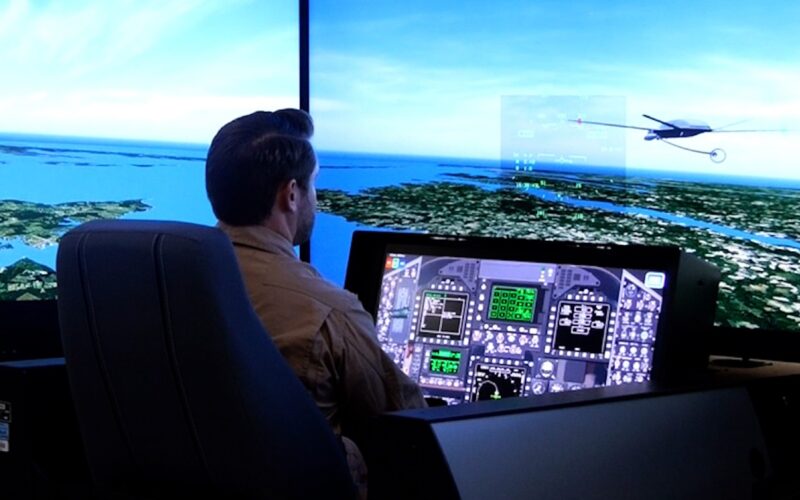Boeing has announced the successful demonstration of an F/A-18 Super Hornet pilot’s ability to control an MQ-25 Stingray unmanned aircraft for mid-air refueling.
This milestone was achieved during a recent virtual test conducted by a Boeing-led team, marking a pivotal moment in the evolution of aerial combat capabilities.
The test in a simulator lab showcased the seamless coordination between the pilot of an F/A-18 Super Hornet and an unmanned MQ-25 Stingray. Under the direction of the US Navy pilot, the Stingray executed the release of a refueling drogue, enabling the Super Hornet to undergo mid-air refueling.
Juan Cajigas, Director of the Advanced MQ-25 program at Boeing, described the complexity of aerial refueling, likening it to a ballet as two aircraft come together.
He pointed out that the pilot’s ability to manage these tasks independently was a major step forward in aerial refueling technology.

The successful simulation verified the effectiveness of new software designed to enhance the interaction between the crewed fighter aircraft and the unmanned MQ-25.
The test incorporated real hardware and data links already installed on both the F/A-18 and MQ-25 platforms, adding a crucial element of realism to the scenario.
Boeing further emphasized that the new software was poised to revolutionize aerial refueling procedures by significantly reducing the time for a F/A-18 pilot to communicate with an MQ-25.
This enhancement would provide pilots greater flexibility in initiating refueling operations from longer distances, improving overall mission effectiveness.
The MQ-25 Stingray is set to take over the refueling duties currently performed by F/A-18 fighters, aiming to reduce the significant amount of flight time spent on refueling missions.
With an estimated 20 to 30 percent of their flight time currently allocated to refueling, the MQ-25 will enable the US Navy to preserve the service life of its Super Hornets while boosting overall mission capability.
Why New Software?
Boeing’s original software design for the MQ-25 required the presence of a human air vehicle operator stationed on an aircraft carrier to remotely initiate refueling, even when the MQ-25 was deployed hundreds of miles away.
This system relied on the Lockheed Martin MD-5 ground control system, which not only supervised the MQ-25 but also managed all other unmanned aerial systems (UAS) launched from carriers.
However, this configuration posed significant challenges, particularly in combat scenarios where the carrier might need to halt electronic signal transmissions.
In response to this, a new software solution is currently being developed. This approach aims to transfer control of the MQ-25’s refueling operation from the carrier-based air vehicle operator to the fighter pilot approaching the UAS.
This new software can enhance operational flexibility and efficiency across a spectrum of combat situations. This shift in control dynamics will streamline the process and ensure adaptability in scenarios where conventional signal transmissions might be compromised.

Alex Ewing, F/A-18 New Product Development lead at Boeing, explained, “MQ-25 is designed to typically receive commands from air vehicle pilots on an aircraft carrier. This software will add a second option, enabling pilots to initiate commands right from their cockpit.”
The latest development is vital for the US Air Force’s ability to project power worldwide, especially in response to challenges posed by adversaries such as China.
The capability to operate beyond national borders hinges heavily on tanker aircraft, which are vital for sustaining operations far from home.
Compared to the Russian Air Force’s meager fleet of 19 tankers, the US Air Force commands an impressive arsenal of 555 tanker aircraft, underscoring its unmatched ability to exert influence and extend its reach worldwide.
The Navy, however, faces inherent challenges in deploying large tanker aircraft from its carriers. One innovative solution to this issue is the introduction of the MQ-25 refueling drone. Stemming from the Carrier-Based Aerial-Refueling System (CBARS) program, the MQ-25 took its inaugural flight in September 2019.
The tanker drone showcased its ability to refuel aircraft in June 2021, successfully refueling with a Super Hornet. With a range of 580 miles while delivering approximately 16,000 lbs of fuel, the MQ-25 fills a crucial logistical role.
Its versatility extends beyond refueling tasks, as it has the potential to be equipped with anti-ship missiles, further enhancing its strategic value in naval operations.
- Contact the author at ashishmichel(at)gmail.com
- Follow EurAsian Times on Google News





